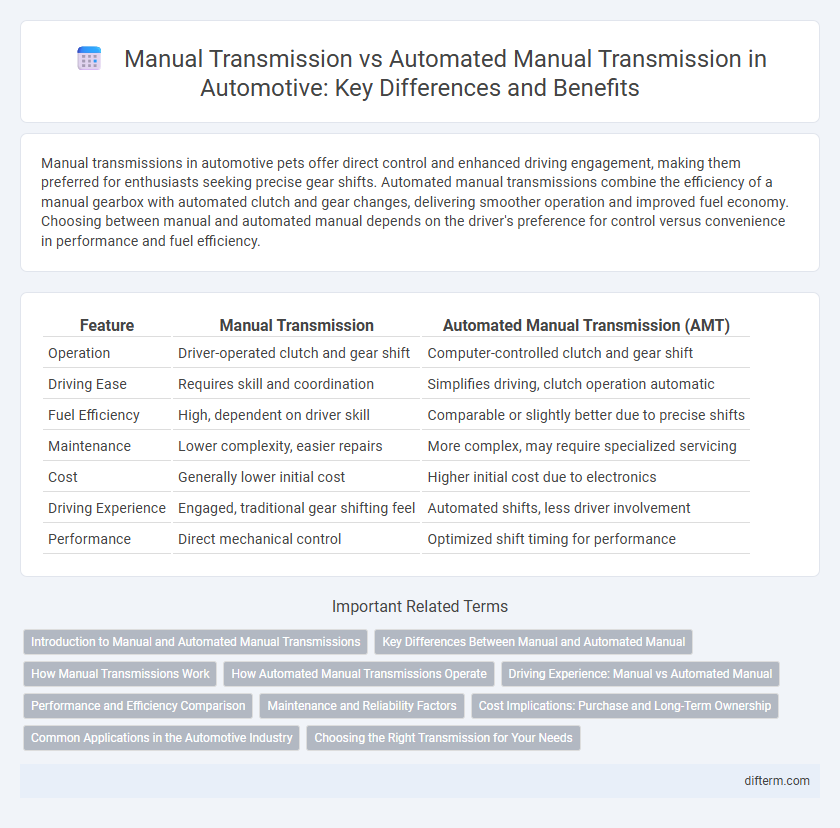Manual transmissions in automotive pets offer direct control and enhanced driving engagement, making them preferred for enthusiasts seeking precise gear shifts. Automated manual transmissions combine the efficiency of a manual gearbox with automated clutch and gear changes, delivering smoother operation and improved fuel economy. Choosing between manual and automated manual depends on the driver's preference for control versus convenience in performance and fuel efficiency.
Table of Comparison
| Feature | Manual Transmission | Automated Manual Transmission (AMT) |
|---|---|---|
| Operation | Driver-operated clutch and gear shift | Computer-controlled clutch and gear shift |
| Driving Ease | Requires skill and coordination | Simplifies driving, clutch operation automatic |
| Fuel Efficiency | High, dependent on driver skill | Comparable or slightly better due to precise shifts |
| Maintenance | Lower complexity, easier repairs | More complex, may require specialized servicing |
| Cost | Generally lower initial cost | Higher initial cost due to electronics |
| Driving Experience | Engaged, traditional gear shifting feel | Automated shifts, less driver involvement |
| Performance | Direct mechanical control | Optimized shift timing for performance |
Introduction to Manual and Automated Manual Transmissions
Manual transmissions require the driver to manually engage the clutch and shift gears, providing greater control and fuel efficiency. Automated manual transmissions combine traditional manual gearbox mechanics with electronic controls to automate clutch operation and gear changes, enhancing convenience without sacrificing fuel economy. This hybrid system offers a balance between driver involvement and automation, often found in modern passenger vehicles and commercial trucks.
Key Differences Between Manual and Automated Manual
Manual transmissions require the driver to manually engage the clutch and shift gears, offering direct control and typically better fuel efficiency. Automated manual transmissions use a computer-controlled clutch and gear shifts, providing convenience by eliminating the need for a clutch pedal while maintaining the mechanical efficiency of a manual gearbox. The primary differences lie in user involvement, shift smoothness, and adaptation to varied driving conditions, with automated manuals delivering ease of use and reduced driver fatigue.
How Manual Transmissions Work
Manual transmissions function by allowing drivers to manually engage and disengage gears using a clutch pedal and gear stick, providing direct control over gear selection to optimize engine power and fuel efficiency. The clutch temporarily disconnects the engine from the transmission, enabling smooth gear shifts without stalling. This system relies on the driver's skill to match engine speed with gear changes, offering a more engaged driving experience compared to automated manuals.
How Automated Manual Transmissions Operate
Automated manual transmissions (AMTs) operate by using electronic controls and actuators to automate clutch engagement and gear shifts typically performed manually by the driver. Sensors monitor engine speed, throttle position, and vehicle load to optimize shift timing, enhancing fuel efficiency and reducing driver effort. This system combines the mechanical efficiency of a manual gearbox with the convenience of automated operation, resulting in smooth, precise gear changes without a traditional torque converter.
Driving Experience: Manual vs Automated Manual
Manual transmissions provide drivers with direct control over gear selection, enhancing engagement and responsiveness during driving. Automated manual transmissions combine the efficiency of manual gear systems with automated clutch operation, offering smoother shifts and reduced driver fatigue in stop-and-go traffic. The driving experience varies as manual transmissions emphasize driver skill and connection, while automated manuals prioritize convenience and ease without sacrificing performance.
Performance and Efficiency Comparison
Manual transmissions provide direct control over gear changes, enhancing driver engagement and allowing precise performance tuning for different driving conditions. Automated manual transmissions (AMTs) combine the efficiency of traditional manuals with automated clutch operation, improving fuel economy by optimizing shift timing and reducing human error. AMTs generally deliver smoother shifts and better consistency, increasing overall driving efficiencywithout sacrificing the mechanical simplicity of manual gearboxes.
Maintenance and Reliability Factors
Manual transmissions generally require more frequent clutch replacements and regular adjustments to maintain optimal performance, increasing maintenance demands compared to automated manual transmissions (AMTs). Automated manual transmissions combine the reliability of conventional manual gearboxes with electronic control systems that reduce driver-induced wear, resulting in extended service intervals and lower maintenance costs. However, AMTs involve complex sensors and actuators, which may lead to higher repair costs and potential reliability issues if not properly maintained.
Cost Implications: Purchase and Long-Term Ownership
Manual transmissions generally have lower initial purchase costs compared to automated manuals, making them more accessible for budget-conscious buyers. Over the long term, manual transmissions tend to incur lower maintenance and repair expenses due to their simpler mechanical design. Automated manual transmissions can lead to higher costs stemming from complex electronic components and potential transmission control unit repairs.
Common Applications in the Automotive Industry
Manual transmissions are widely used in compact cars and performance vehicles where driver control and engagement are prioritized. Automated manual transmissions (AMTs) find common applications in commercial vehicles and small passenger cars, offering fuel efficiency and reduced driver fatigue without the complexity of traditional automatics. The choice between these systems depends on factors like cost, driving environment, and vehicle type, influencing adoption across various automotive segments.
Choosing the Right Transmission for Your Needs
Manual transmissions offer precise control and greater driver engagement, making them ideal for enthusiasts seeking a more connected driving experience. Automated manual transmissions combine the fuel efficiency and mechanical simplicity of manuals with the convenience of automated gear changes, appealing to drivers prioritizing ease of use in urban environments. Selecting the right transmission depends on balancing factors like driving style, fuel economy, and traffic conditions to match personal preferences and daily requirements.
manual vs automated manual Infographic

 difterm.com
difterm.com